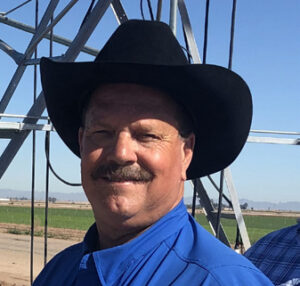Ronald Leimgruber is a third-generation farmer in California’s Imperial Valley who uses a variety of irrigation methods to grow his crops. He has been using Rubicon’s technology for over 10 years.
Irrigation Leader: Please tell us about yourself and your farming operations.
Ronald Leimgruber: I’m a third-generation farmer. I started farming in the 1980s after graduating from college with a business degree. My grandparents and my dad were dairy, livestock, and crop farmers. We’ve diversified into produce crops, onions, carrots, alfalfa, and seed crops. We have about 2,022 acres.
Irrigation Leader: What are your main irrigation methods?
Ronald Leimgruber: We implement six different methods. Predominantly, we do surface line border check irrigation, which is the predominant method in the Imperial Valley. That means our fields are laser leveled to a precise slope and flooded from one end to the other. We also use drip irrigation; overhead linear move irrigation, which is similar to center-pivot irrigation but linear instead of circular; solid-set irrigation, which uses 3‑inch dam lines to germinate our crops; level basin irrigation, where the ground is 100 percent level and we run water in for a fixed amount of time; and furrow irrigation, which is used for certain produce crops.
Irrigation Leader: Please tell us about your experience using Rubicon’s FarmConnect system.
Ronald Leimgruber: The Rubicon system has two parts. The automatic gates help you control your water by sensing where it is opening and closing automatically. The smart connect part of it monitors the amount of water you’re putting in each basin and helps to minimize your tail water and runoff water. In the Imperial Valley, because of the slopes of our ground, we have to saturate the lower end of the field as much as the upper end, so a certain amount of tail water is necessary, but we’re trying to minimize it as much as we can. One of the benefits of the FarmConnect system is that it allows us to monitor our water on each bay and the runoff water and to calibrate the difference to conserve water. We have plans to install two additional FarmConnect systems.
Irrigation Leader: What are some of the benefits of automation and remote control for your operations?
Ronald Leimgruber: It’s definitely a carbon-saving method. We don’t have to drive out to the field multiple times a day to check on where the water is, because we have sensors out there. We get increased production, we get more uniformity of water application, we get water savings because we’re minimizing our tail water, and we get labor savings because we don’t have to pay the irrigator to monitor the water.
Irrigation Leader: More generally, what are the benefits of transforming flood irrigation using a technology like this?
Ronald Leimgruber: I’ve been using this system for 12 years now, and you have to apply larger volumes of water in shorter amounts of time. You try to be as efficient with your water as you can because the lower end of your field needs opportunity time for that water to infiltrate into the soil. If you get too much infiltration time, you get excessive water past your root zone. We need that in Imperial Valley soils, because every acre-foot of Colorado River water we apply contains 2,000 pounds of salt. The only way to keep our soils productive is to overirrigate our soils by about 10–15 percent so that we drive the water to our tile system, which takes the salts out to the Salton Sea and keeps our soil in balance. With the Rubicon system, you have to be really careful that you keep that high level of water infiltration, but it’ll definitely save labor and water and increase production. You need to do all three of those things to be profitable in farming nowadays. Your margins are so thin—all you get to work with is about 5 percent—and if I can increase that to 7 percent, that’s a big difference.
Ronald Leimgruber farms in Holtville, California. He can be contacted at rclfarms@earthlink.net.

